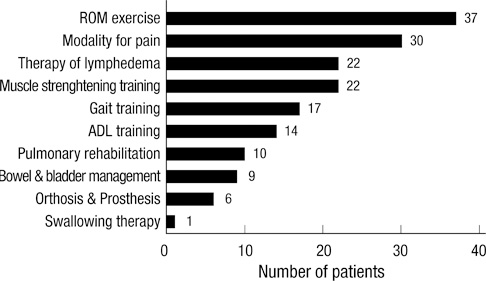J Korean Med Sci.
2011 May;26(5):619-624. 10.3346/jkms.2011.26.5.619.
Cancer Rehabilitation: Experience, Symptoms, and Needs
- Affiliations
-
- 1Department of Rehabilitation Medicine, Asan Medical Center, University of Ulsan College of Medicine, Seoul, Korea. kysmart@amc.seoul.kr
- 2Department of Preventive Medicine, Asan Medical Center, University of Ulsan College of Medicine, Seoul, Korea.
- KMID: 1777859
- DOI: http://doi.org/10.3346/jkms.2011.26.5.619
Abstract
- The aim of this study was to examine the experience of cancer patients undergoing rehabilitation, to identify symptoms associated with rehabilitation from cancer, and to assess the need for rehabilitation services for cancer patients. Cancer patients (n = 402) at the Asan Medical Center (Seoul, Korea) were enrolled from June to September 2008. A chart review was used to collect demographic and clinical data, including type of cancer, current treatment, time from initial diagnosis to screening, and cancer stage. Each participant provided informed consent and was then given a questionnaire that asked about experience with rehabilitation, symptoms associated with rehabilitation, and the need for different types of rehabilitation services. Clinicians recommended rehabilitation for 8.5% of patients, and 6.7% underwent rehabilitation. Among study patients, 83.8% had one or more symptoms associated with rehabilitation, and 71.6% of patients with symptoms wanted rehabilitation management. The need for rehabilitation was associated with the presence of metastasis, advanced cancer stage, time to diagnosis, and type of current treatment. Our results provide specific information about particular functional symptoms and the rehabilitative needs of subgroups of cancer patients. It is suggested to develope and implement rehabilitation programs for cancer patients.
Keyword
MeSH Terms
Figure
Reference
-
1. Jung KW, Park S, Kong HJ, Won YJ, Boo YK, Shin HR, Park EC, Lee JS. Cancer statistics in Korea: incidence, mortality and survival in 2006-2007. J Korean Med Sci. 2010. 25:1113–1121.2. Dietz JH Jr. Rehabilitation of the cancer patient. Med Clin North Am. 1969. 53:607–624.3. Gerber LH, Vargo MM, Smith RG. Devita V, Hellman S, Rosenberg S, editors. Rehabilitation of the cancer patient. Cancer: principles and practice of oncology. 2005. 7 ed. Philadelphia: Lippincott Williams and Wilkins;3089–3110.4. Chang VT, Hwang SS, Feuerman M, Kasimis BS. Symptom and quality of life survey of medical oncology patients at a veterans affairs medical center: a role for symptom assessment. Cancer. 2000. 88:1175–1183.5. Cheville AL, Beck LA, Petersen TL, Marks RS, Gamble GL. The detection and treatment of cancer-related functional problems in an outpatient setting. Support Care Cancer. 2009. 17:61–67.6. Curtis EB, Krech R, Walsh TD. Common symptoms in patients with advanced cancer. J Palliat Care. 1991. 7:25–29.7. Lehmann JF, DeLisa JA, Warren CG, deLateur BJ, Bryant PL, Nicholson CG. Cancer rehabilitation: assessment of need, development, and evaluation of a model of care. Arch Phys Med Rehabil. 1978. 59:410–419.8. Patrick DL, Ferketich SL, Frame PS, Harris JJ, Hendricks CB, Levin B, Link MP, Lustig C, McLaughlin J, Ried LD, Turrisi AT 3rd, Unützer J, Vernon SW. National Institutes of Health State-of-the-Science Panel. National Institutes of Health State-of-the-Science Conference Statement: Symptom Management in Cancer: Pain, Depression, and Fatigue, July 15-17, 2002. J Natl Cancer Inst. 2003. 95:1110–1117.9. Portenoy RK, Thaler HT, Kornblith AB, Lepore JM, Friedlander-Klar H, Coyle N, Smart-Curley T, Kemeny N, Norton L, Hoskins W. Symptom prevalence, characteristics and distress in a cancer population. Qual Life Res. 1994. 3:183–189.10. Vogelzang NJ, Breitbart W, Cella D, Curt GA, Groopman JE, Horning SJ, Itri LM, Johnson DH, Scherr SL, Portenoy RK. Patient, caregiver, and oncologist perceptions of cancer-related fatigue: results of a tripart assessment survey. The Fatigue Coalition. Semin Hematol. 1997. 34:3 Suppl 2. 4–12.11. Park SB, Krishnan AV, Lin CS, Goldstein D, Friedlander M, Kiernan MC. Mechanisms underlying chemotherapy-induced neurotoxicity and the potential for neuroprotective strategies. Curr Med Chem. 2008. 15:3081–3094.12. Amato AA, Dumitru D. Dumitru D, Amato AA, Swartz MJ, editors. Acquired myopathy. Electrodiagnostic medicine. 2002. 2nd ed. Philadelphia: Hanley & Belfus;1265–1432.13. Bentzen SM, Dische S. Morbidity related to axillary irradiation in the treatment of breast cancer. Acta Oncol. 2000. 39:337–347.14. Beesley V, Janda M, Eakin E, Obermair A, Battistutta D. Lymphedema after gynecological cancer treatment: prevalence, correlates, and supportive care needs. Cancer. 2007. 109:2607–2614.15. McLaughlin SA, Wright MJ, Morris KT, Giron GL, Sampson MR, Brockway JP, Hurley KE, Riedel ER, Van Zee KJ. Prevalence of lymphedema in women with breast cancer 5 years after sentinel lymph node biopsy or axillary dissection: objective measurements. J Clin Oncol. 2008. 26:5213–5219.16. García-Peris P, Parón L, Velasco C, de la Cuerda C, Camblor M, Bretón I, Herencia H, Verdaguer J, Navarro C, Clave P. Long-term prevalence of oropharyngeal dysphagia in head and neck cancer patients: impact on quality of life. Clin Nutr. 2007. 26:710–717.17. Walsh D, Rybicki L. Symptom clustering in advanced cancer. Support Care Cancer. 2006. 14:831–836.18. Hwang SS, Chang VT, Cogswell J, Alejandro Y, Osenenko P, Morales E, Srinivas S, Kasimis B. Study of unmet needs in symptomatic veterans with advanced cancer: incidence, independent predictors and unmet needs outcome model. J Pain Symptom Manage. 2004. 28:421–432.19. Mor V, Allen SM, Siegel K, Houts P. Determinants of need and unmet need among cancer patients residing at home. Health Serv Res. 1992. 27:337–360.20. Mor V, Masterson-Allen S, Houts P, Siegel K. The changing needs of patients with cancer at home. A longitudinal view. Cancer. 1992. 69:829–838.21. Sanson-Fisher R, Girgis A, Boyes A, Bonevski B, Burton L, Cook P. The unmet supportive care needs of patients with cancer. Supportive Care Review Group. Cancer. 2000. 88:226–237.
- Full Text Links
- Actions
-
Cited
- CITED
-
- Close
- Share
- Similar articles
-
- Cancer Rehabilitation Fact Sheet in Korea
- Overview of cancer rehabilitation
- The Changes in Interest and Attitudes of Nursing Students toward the Disabled before and after the Disability Experience Program
- Factors that Influence Korean Breast Cancer Patients to Undergo Cancer Rehabilitation Therapy
- Polarization of cancer patient management




